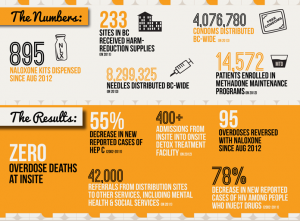My first and only encounter with rehabilitation treatment was at the age of 16, when one of my closest friends was involuntarily sent to a treatment center in Utah. Jane* had been struggling with substance abuse for a short while, and prematurely, her parents deemed it necessary to take action. Despite protest and unwillingness, she endured four months of wilderness therapy in a remote national park of Utah. Upon her return, we anticipated a “reformed” young woman; instead, Jane was found using alone on the night of her homecoming and despite any attempts at rehabilitation she continues to struggle with her addiction today.
On a recent visit to Insite, Canada’s first legal supervised-injection site (SIF), I was reminded of Jane’s experience with detoxification. Specifically, I learned about the facility’s partner site Onsite, a short-term detox center, which piqued my interest in alternatives to traditional detoxification processes. The one to two-week long treatment clinic is located directly above Insite’s facility and is accessible to all, but most importantly, the marginalized community of the Downtown Eastside (DTES). Onsite lists their approach to rehabilitation as an innovative alternative to conventional practices, rooted in human connection and flexibility. The clinic is comprised of detox and transitional housing floors and has seen over 2,800 intakes since its inception in 2007 (Insite).

From our tour of the facility, I learned about how Onsite’s combination of harm reduction practices and alternative therapy have become an effective approach to detox; the methods of the complimentary clinic consist primarily of building relationships and establishing support, even in the case of relapse. The process in which individuals enter the program is especially important in Onsite’s operation: instead of forceful and paid rehabilitation services, patients are admitted based on commitment and willingness. If users demonstrate their desire to reform through continually visiting Insite and “the chill room”, they are accepted into the program. The tenants of Onsite promote a positive mindset for rehabilitation and provide a safe space for marginalized individuals to receive the necessary help.
The Drug Rehab Services of Canada lists 190 drug rehabilitation clinics in the City of Vancouver; of these, only one is considered a legitimate short-term detox facility and it is not Onsite. Although this program provides inventive and effective rehabilitation treatment, it is notably excluded from the roster of government-recognized treatment facilities. In the Journal of Substance Abuse Treatment, Gaddis et al. found that the use of Onsite led to a 30% increase in the enrollment of further rehabilitation and is correlated with the cessation of use of SIF facilities. Thus, it can be inferred from these statistics that the use of short-term detox facilities can reduce the likelihood of relapse and bolster community harm reduction efforts.

I believe that an increase in the conception of free, short-term rehabilitation centers similar to Onsite would minimize addiction rates and promote harm reduction practices. It is difficult to enter traditional rehabilitation for many individuals in communities such as the DTES, due to financial and social reasons. The rigidity of formal clinics acts as a barrier for certain demographics and undermines the process of total detoxification. In more marginalized communities, it is pivotal to provide support for those suffering from addiction due to their susceptibility to the forces of their society. The erection of more harm reduction-based detox programs that provide support even after rehabilitation would generate success in the realm of addiction-prevention and relapse.
Upon learning about Onsite and re-examining Jane’s unsuccessful experience with rehabilitation, I have developed a new outlook on the process of detoxification. Jane’s rehab clinic had a converse effect to that which was intended; she developed a greater knowledge on how to conceal and sustain her addiction, harboring a stronger desire to use once having completed her program. The creation of Onsite in co-location with Insite has led to a decrease in public injections and uptake in further rehabilitation clinics (Gaddis et al.). If a facility such as Onsite had been at her disposal, I believe it would have greatly improved her chances at sobriety. The desire for sobriety is in the hands of the individual, and unless a user feels supported and prepared to enter a rehab facility, their chances of becoming clean are slim. Onsite provides opportunities for sobriety unbeknownst to traditional rehab and creates a safe space for users to heal.
*Name changed for privacy